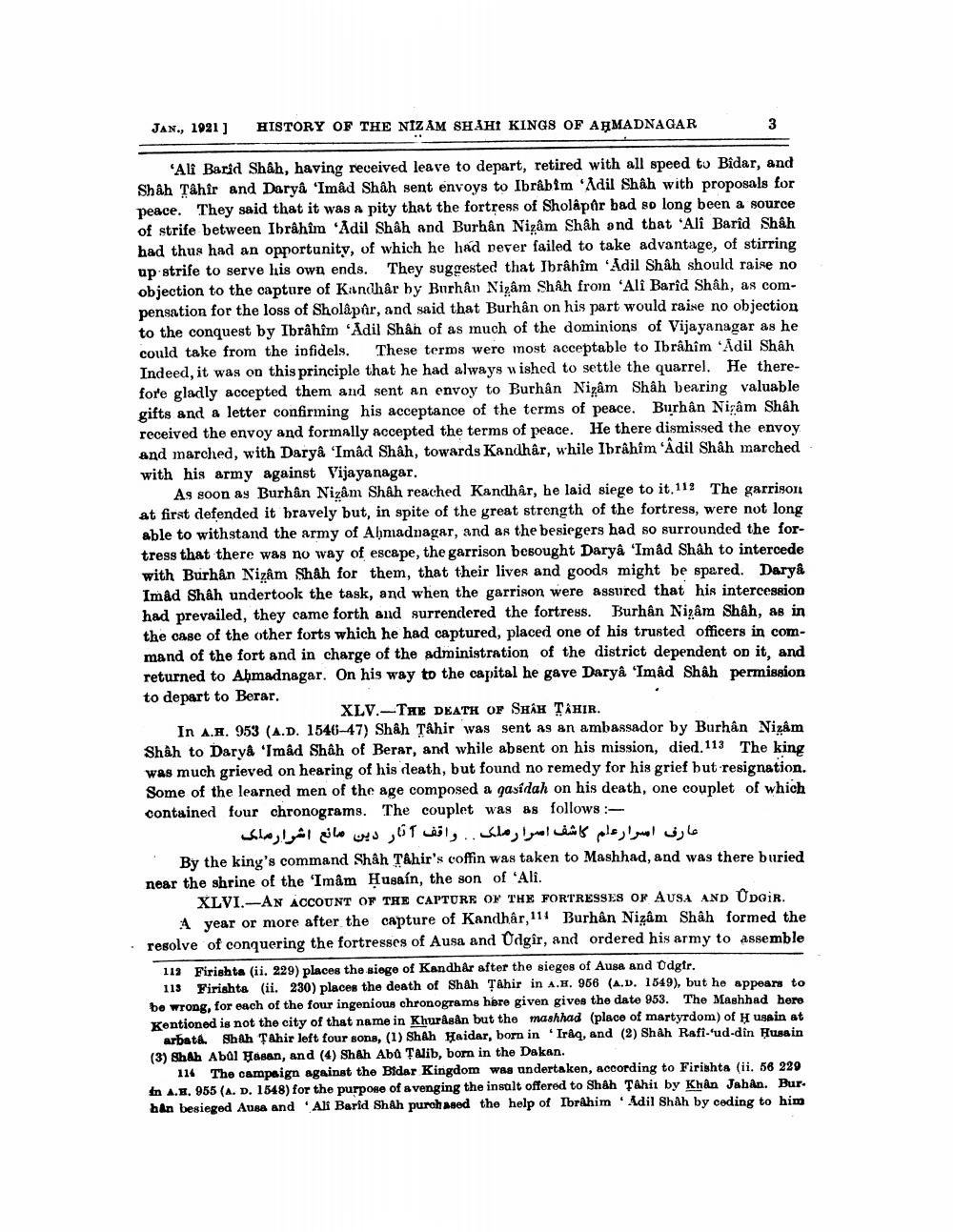________________
3
JAN., 1921] HISTORY OF THE NIZAM SHAHI KINGS OF AHMADNAGAR
'Ali Barid Shah, having received leave to depart, retired with all speed to Bidar, and Shah Tâhîr and Daryâ 'Imâd Shâh sent envoys to Ibrâbim 'Adil Shâh with proposals for peace. They said that it was a pity that the fortress of Sholapur bad so long been a source of strife between Ibrâhîm 'Adil Shâh and Burhân Nizâm Shâh and that 'Alî Barîd Shâh had thus had an opportunity, of which he had never failed to take advantage, of stirring up strife to serve his own ends. They suggested that Ibrâhîm 'Adil Shâh should raise no objection to the capture of Kandhâr by Burhân Nigâm Shâh from 'Alî Barîd Shah, as compensation for the loss of Sholapur, and said that Burhân on his part would raise no objection to the conquest by Ibrâhîm 'Adil Shân of as much of the dominions of Vijayanagar as he could take from the infidels. These terms were most acceptable to Ibrâhîm Adil Shâh Indeed, it was on this principle that he had always wished to settle the quarrel. He therefore gladly accepted them and sent an envoy to Burhân Nigâm Shâh bearing valuable gifts and a letter confirming his acceptance of the terms of peace. Burhân Nizâm Shah received the envoy and formally accepted the terms of peace. He there dismissed the envoy. and marched, with Daryâ 'Imâd Shâh, towards Kandhar, while Ibrâhîm 'Adil Shâh marched with his army against Vijayanagar.
As soon as Burhân Nizâm Shâh reached Kandhar, he laid siege to it. 112 The garrison at first defended it bravely but, in spite of the great strength of the fortress, were not long able to withstand the army of Ahmadnagar, and as the besiegers had so surrounded the fortress that there was no way of escape, the garrison besought Daryâ 'Imâd Shâh to intercede with Burhân Nizam Shah for them, that their lives and goods might be spared. Daryâ Imad Shah undertook the task, and when the garrison were assured that his intercession had prevailed, they came forth and surrendered the fortress. Burhân Nizam Shah, as in the case of the other forts which he had captured, placed one of his trusted officers in command of the fort and in charge of the administration of the district dependent on it, and returned to Ahmadnagar. On his way to the capital he gave Daryâ 'Imâd Shâh permission to depart to Berar.
XLV. THE DEATH OF SHAH TAHIR.
In A.H. 953 (A.D. 1546-47) Shah Tahir was sent as an ambassador by Burhân Nizâm Shah to Darya 'Imâd Shâh of Berar, and while absent on his mission, died. 113 The king was much grieved on hearing of his death, but found no remedy for his grief but resignation. Some of the learned men of the age composed a gasidah on his death, one couplet of which contained four chronograms. The couplet was as follows:
عارف اسراره ام کاشف اسرار ملک . . واقف آثار دین مانع اشرارماک
By the king's command Shâh Tâhir's coffin was taken to Mashhad, and was there buried near the shrine of the 'Imâm Husaín, the son of 'Ali.
XLVI. AN ACCOUNT OF THE CAPTURE OF THE FORTRESSES OF AUSA AND ÛDGIR. A year or more after the capture of Kandhår, 114 Burhân Nizam Shah formed the resolve of conquering the fortresses of Ausa and Udgir, and ordered his army to assemble
113 Firishta (ii. 229) places the siege of Kandhår after the sieges of Ausa and Udgir.
113 Firishta (ii. 230) places the death of Shah Tahir in A.H. 956 (A.D. 1549), but he appears to be wrong, for each of the four ingenious chronograms here given gives the date 953. The Mashhad here Kentioned is not the city of that name in Khurâsân but the mashhad (place of martyrdom) of Husain at arbata. Shah Tahir left four sons, (1) Shah Haidar, born in Iraq, and (2) Shah Rafi-ud-din Husain (3) Shah Abul Hasan, and (4) Shah Abu Talib, born in the Dakan.
114 The campaign against the Bidar Kingdom was undertaken, according to Firishta (ii. 56 229 in A.H. 955 (A. D. 1548) for the purpose of avenging the insult offered to Shah Tahit by Khân Jahan. Bur. han besieged Ausa and Ali Barid Shah purchased the help of Ibrahim Adil Shah by ceding to him




